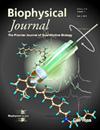自由能转换机制塑造了代谢网络的通量空间
IF 3.2
3区 生物学
Q2 BIOPHYSICS
引用次数: 0
摘要
新陈代谢网络中的自由能转换是一种热力学机制,通过这种机制,从营养物质中获得的自由能被转换为非自发的、需要能量的新陈代谢反应的动力。这种转换通常发生在产生 ATP 和 NAD(P)H 等富含能量分子的过程中,而 ATP 和 NAD(P)H 又反过来为特定反应,特别是生物合成反应提供能量。这一特性建立了新陈代谢网络错综复杂的拓扑结构与其为功能目的重新分配能量的能力之间的关键联系。本研究提出了一个专门的框架,旨在探索自由能耗散、网络拓扑结构和代谢目标之间的关系。研究的出发点是,无论网络拓扑结构如何,非平衡化合条件都会对可行的通量稳态施加严格的热力学约束,以满足能量和熵的平衡。对随机取样反应网络的分析表明,网络拓扑结构还施加了额外的约束,限制了可访问的通量解决方案空间,这取决于反应的分子性、反应周期和守恒定律等关键结构特征。值得注意的是,以实施自由能转换机制的多分子反应为特征的拓扑结构往往会扩展可访问的通量域,从而有利于实现同化通量最大化或通量改道能力等代谢目标。这种方法被应用于碳水化合物代谢的粗粒度模型,突出了最佳生物质产量的结构要求。本文章由计算机程序翻译,如有差异,请以英文原文为准。
Free-energy transduction mechanisms shape the flux space of metabolic networks
The transduction of free energy in metabolic networks represents a thermodynamic mechanism by which the free energy derived from nutrients is converted to drive nonspontaneous, energy-requiring metabolic reactions. This transduction is typically observed in processes that generate energy-rich molecules such as ATP and NAD(P)H, which, in turn, power specific reactions, particularly biosynthetic reactions. This property establishes a pivotal connection between the intricate topology of metabolic networks and their ability to reroute energy for functional purposes. The present study proposes a dedicated framework aimed at exploring the relationship between free-energy dissipation, network topology, and metabolic objectives. The starting point is that, regardless of the network topology, nonequilibrium chemostatting conditions impose stringent thermodynamic constraints on the feasible flux steady states to satisfy energy and entropy balance. An analysis of randomly sampled reaction networks shows that the network topology imposes additional constraints that restrict the accessible flux solution space, depending on key structural features such as the reaction’s molecularity, reaction cycles, and conservation laws. Notably, topologies featuring multimolecular reactions that implement free-energy transduction mechanisms tend to extend the accessible flux domains, facilitating the achievement of metabolic objectives such as anabolic flux maximization or flux rerouting capacity. This approach is applied to a coarse-grained model of carbohydrate metabolism, highlighting the structural requirements for optimal biomass yield.
求助全文
通过发布文献求助,成功后即可免费获取论文全文。
去求助
来源期刊

Biophysical journal
生物-生物物理
CiteScore
6.10
自引率
5.90%
发文量
3090
审稿时长
2 months
期刊介绍:
BJ publishes original articles, letters, and perspectives on important problems in modern biophysics. The papers should be written so as to be of interest to a broad community of biophysicists. BJ welcomes experimental studies that employ quantitative physical approaches for the study of biological systems, including or spanning scales from molecule to whole organism. Experimental studies of a purely descriptive or phenomenological nature, with no theoretical or mechanistic underpinning, are not appropriate for publication in BJ. Theoretical studies should offer new insights into the understanding ofexperimental results or suggest new experimentally testable hypotheses. Articles reporting significant methodological or technological advances, which have potential to open new areas of biophysical investigation, are also suitable for publication in BJ. Papers describing improvements in accuracy or speed of existing methods or extra detail within methods described previously are not suitable for BJ.
 求助内容:
求助内容: 应助结果提醒方式:
应助结果提醒方式:


